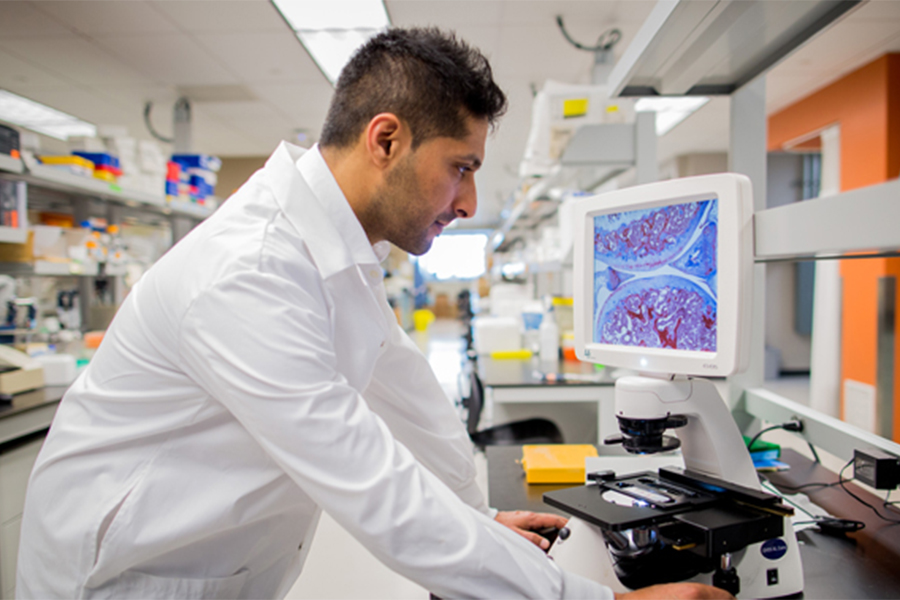
It’s estimated six million Canadians live with arthritis, making it the most common chronic disease in Canada. It’s a condition that causes pain, swelling and stiffness in the joints — the places where two bones meet, such as your knees, fingers, or hips.
There are more than 100 types of arthritis, with the two most common forms being Osteoarthritis and Rheumatoid arthritis. There is no cure for arthritis, making research into the disease critical.
To mark Arthritis Awareness Month, Dr. Mohit Kapoor and Dr. Robert Inman, Co-Directors of UHN’s Schroeder Arthritis Institute — the largest multidisciplinary arthritis institute in Canada discuss the latest on arthritis treatment and research at UHN.
Q: What is the status of UHN’s care, treatment and research of arthritis, and how does the Schroeder Arthritis Institute lead the way?
A: UHN’s Schroeder Arthritis Institute is one of the top integrated institutions with full integration of research, clinical care and education. This is a formula for success where not only clinical care is provided to our patients, but we also do world-class research and provide exceptional training and mentoring.
Our mission at the Institute is to deliver the right care at the right time for every patient living with arthritis. Our research spans a wide range of disciplines including basic science, clinical research, epidemiology and applied research, reflecting the complexity and diversity of arthritic diseases. We focus on multiple forms of arthritis, including psoriatic arthritis, spondyloarthritis, osteoarthritis, rheumatoid arthritis, lupus, scleroderma, Sjögren’s syndrome and many others.
One of our key priorities is osteoarthritis, where current treatment options primarily focus on symptoms management, particularly pain relief. Unfortunately, these treatments do not halt or reverse disease progression. Our goal is to develop disease-modifying therapies and drugs that can stop or slow down the underlying disease process.
Currently, there are no approved disease-modifying drugs for osteoarthritis. However, our team is deeply engaged in vigorous, multi-disciplinary research efforts to change that. For many of the immune-mediated forms of arthritis, such as spondylarthritis and psoriatic arthritis, investigators in our Institute are at the forefront of advances in early diagnosis and treatment. In systemic rheumatic diseases, such as lupus and scleroderma, our clinician scientists are undertaking innovative immune therapies and cell-based approaches which have the potential to be curative for these chronic disabling conditions.
At the Schroeder Arthritis Institute, we are working to better understand disease mechanisms, identify novel therapeutic targets, develop and test potential disease-modifying drugs and improve our understanding of patient experiences and outcomes.
Q: What would be the benefit of early diagnosis and how does the Schroeder Arthritis Institute play a role in this?
A: The notion is that the earlier the diagnosis, the earlier the intervention, which provides us with the best chance to halt the disease. Early detection allows physicians to apply the right therapies at the right time, with the goal of treating before irreversible joint damage occurs. This is still a work in progress, but that is our goal on where we want to be.
For example, osteoarthritis is often detected when damage is already significant. However, promising tools and technologies being developed at both the Schroeder Arthritis Institute and globally, are beginning to offer hope.
The Institute has a great team of researchers, scientists, clinicians, orthopedic surgeons, rheumatologists, bone biologists, epidemiologists, computational, artificial intelligence, machine learning and other expertise, which are all geared towards early diagnosis and early intervention tools for various forms of arthritis.

Q: How far have we come in understanding osteoarthritis and its treatment today versus 10-20 years ago?
A: From a research perspective, osteoarthritis represents one of the most pressing global health challenges. By 2050, it is projected that close to 1 billion people worldwide will be affected by osteoarthritis.
In the past, osteoarthritis was largely considered a condition involving gradual deterioration of cartilage. However, our understanding has evolved significantly over the last few decades. Today, we recognize osteoarthritis as a complex, whole-joint disease, involving not just cartilage, but bone, ligaments, synovium and even systemic processes beyond the joint.
This shift in understanding is one of the major breakthroughs in recent osteoarthritis research. However, with deeper insights come new challenges. Even as we learn more about disease progression, we are now focused on developing and testing potential disease-modifying treatments that go far beyond symptom relief.
At the Schroeder Arthritis Institute, our research and clinical care span the entire spectrum of osteoarthritis, including early detection and diagnostics, novel drug development, therapeutic testing and surgical innovations for advanced disease.
For patients with advanced osteoarthritis, the Schroeder Arthritis Institute is home to world-leading orthopedic surgeons, offering cutting-edge treatments including robotic-assisted joint replacement surgeries. The Institute became one of the first in Canada to implement advanced robotic technologies in knee replacement surgery, helping set a new standard in precision, recovery and outcomes.
For inflammatory joint diseases such as spondyloarthritis and psoriatic arthritis, systemic rheumatic diseases such as lupus and scleroderma, and metabolic bone diseases such as osteoporosis, our expert clinicians work hand in hand with our immunologists and basic scientists. There are major changes at hand in developing targeted therapies which can fundamentally reset the immune imbalance underlying these diseases. With the convergence of clinical expertise and cutting-edge science, our Institute is positioned to take a national and international leadership position in personalized medicine.
Similarly, advances in surgical techniques for traumatic joint injury have established our hand program and our orthopedics division at the forefront of efforts to address these disabling conditions. The overriding goal is to restore such patients to full function and quality of life.
What areas of arthritis research are you most excited about?
The application of advanced data analytics, deep learning tools and machine learning techniques, to understand the complex and different types of arthritis is something we are very excited about.
At the Schroeder Arthritis Institute, we are fortunate to have world-class international experts who work on these cutting-edge technologies. We are deeply interested in the emerging therapies currently in the pipeline and we are motivated by the possibility that these treatments may halt disease progression and eventually transition from the lab to the clinic.
It is a privilege to be part of a field where scientific innovation has such a direct and meaningful potential to improve patients’ lives. We all work together to back a collective goal — to improve the lives of our patients and to stop these debilitating forms of arthritis. Through collaboration and innovation, the Schroeder Arthritis Institute is dedicated to pushing the boundaries of arthritis research and transforming care for patients worldwide. That is our mission.

No one ever changed the world on their own but when the bright minds at UHN work together with donors we can redefine the world of health care together.


